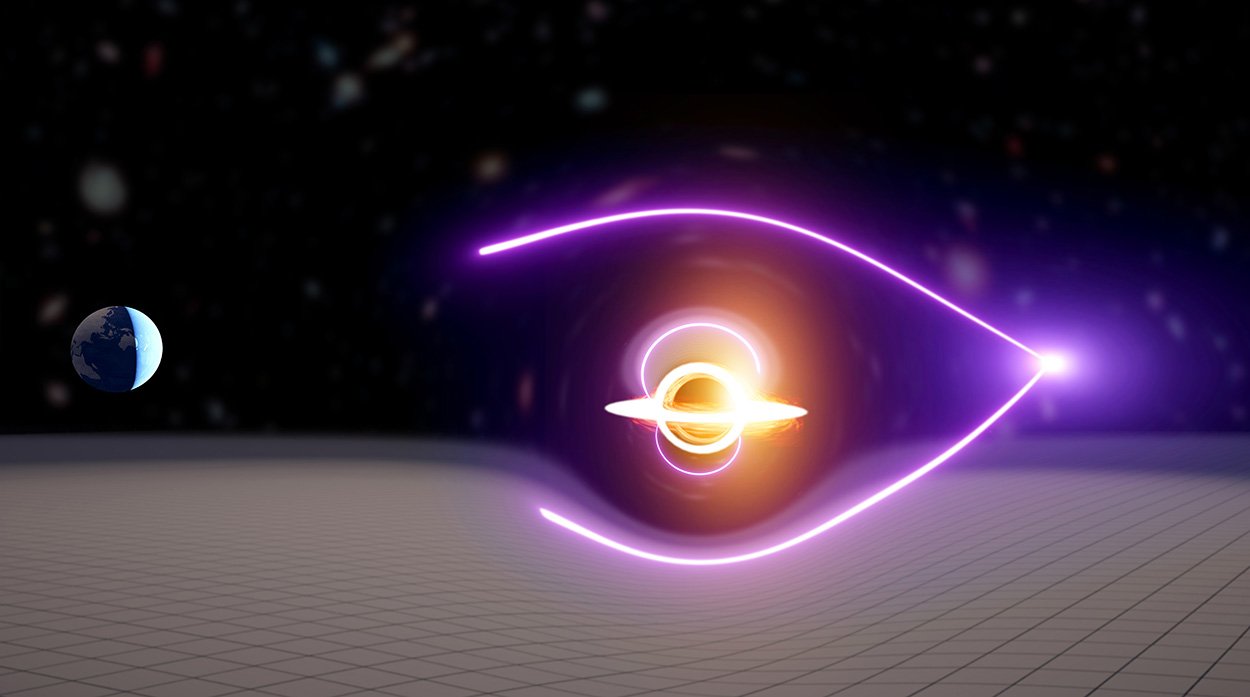
Gamma rays reveal the presence of an average black hole
Medium black holes have so far been seen as a “missing link,” because only a few candidate medium-sized black holes have been discovered so far. Now a team of astronomers has tracked down another sample from this intermediate stage between stellar and supermassive black holes. This worked because this object acted like a gravitational lens and its mass distorted the far-wave radiation of gamma rays in a distinctive way. According to this, this object has a mass of 55,000 solar masses, so it cannot have formed in a simple star explosion, and it cannot sit like a supermassive giant gravity in the center of a galaxy.
Almost all black holes discovered by astronomers so far fall into two categories. Either they are stellar black holes with a maximum of about 50 solar masses, such as those formed in a supernova of a massive star. Or they are supermassive giants with a mass of one to ten billion solar masses located in the center of galaxies. However, in the range of the block between them, there is a gap, although according to the theory there should also be intermediate black holes. This could result from multiple stellar black hole mergers, as likely occurs in the core of globular clusters, or from massive stars merging into a massive star about 1,000 solar masses, which then collapses into a black hole. However, there are still only a few candidates for such “missing links” in the black hole community.
Tale echoes in a gamma-ray pulse
Now astronomers working with James Painter at the University of Melbourne can track down another candidate for an intermediate black hole – in a new way. For their study, the team evaluated subtle delays in light from distant gamma-ray bursts. These short but extremely powerful explosions of rays occur, among other things, in supernovae or star collisions. Part of the energy released in the process is radiated into space in the form of flashes of short-wave, very high-energy gamma rays, which can still be detected with gamma-ray telescopes in Earth’s orbit even from millions or even billions of light-years away. When these gamma rays pass through a large, compact object on their way to Earth, for example a galaxy, a star cluster, or even a larger black hole, their gravitational impact causes a slight deviation from the radiation.
This leads to the effect of a gravitational lens: with visible light, light distortion caused by gravity can enlarge double images or loops of light; It is similar to gamma rays. But because gamma-ray telescopes do not have a sufficiently high spatial resolution, the gravitational lens effect appears in them as characteristic splitting and delay of the signal: “The observed signature of this lens event is an initial gamma-ray pulse followed by an“ echo, ”Baynter and his team explain. The interesting thing is: Through the delay and properties of this echo, it is possible to read the mass and properties of the cosmic object that led to the deflection of the gamma radiation, so the researchers searched in a dataset of 2,700 gamma-ray bursts for an echo signal having the characteristics of a medium black hole.
Lens flare matches the average black hole
Astronomers found what they were looking for in a gamma-ray burst: The short burst GRB 950830 showed a radial curve indicating the effect of a gravitational lens at about 55,000 solar masses. “In this mass scale, there are three astrophysical objects that can act as lenses: globular clusters, halos of dark matter or black holes,” Pinter and colleagues wrote. According to your calculations, globular clusters are very rare and halos with an internal distribution of their mass do not match the observed gamma-ray distortion. In the opinion of astronomers, there is much that suggests the existence of a black hole behind the influence of a gravitational lens during a gamma-ray burst. Because of its mass, it must be one of the long-awaited intermediate black holes.
Also exciting: “This newly discovered black hole could be an ancient remnant – a primitive black hole formed in the early universe by the first stars and galaxies,” explains co-author Eric Thrin of Monash University. “These early black holes could be the nucleus of the supermassive black holes in the core of galaxies today.” Because it’s only partially explained how the heaviest representatives of black holes form. However, astronomers assume that they were formed by the fusion of smaller and more developed precursors. “We know that these supermassive black holes exist at the centers of most, if not all, galaxies. But we still do not understand how these giants could have become so big since the beginning of the universe,” Pinter adds.
Quelle: Natural Astronomy, Doi: 10.1038 / s41550-021-01307-1

“Organizer. Social media geek. General communicator. Bacon scholar. Proud pop culture trailblazer.”
